
Ohio’s LGBTQ+ Rights Saga: Unmasking the Gender-Affirming Care Ban
Ohio recently made headlines by banning gender-affirming care for minors and imposing restrictions on transgender athletes. In a move that divided the state, the Republican-dominated Senate successfully overrode GOP Gov. Mike DeWine’s veto, ushering in a new era of challenges for transgender individuals and their families.
Legislative Landscape
The controversial law, expected to take effect in approximately 90 days, prohibits gender-affirming surgeries, hormone therapies, and mental health care for transgender individuals under 18. Additionally, it bars transgender girls and women from participating in sports teams at both K-12 and collegiate levels. This legislative trend aligns with similar actions in at least 23 other states, signaling a contentious nationwide debate.
Impact on Transgender Families
For families like Kat Scaglione’s, the legislation has brought distress and uncertainty. With two transgender children, Scaglione is grappling with the potential limitations on her 14-year-old daughter Amity’s gender-affirming care. The law’s grandfather clause may offer a lifeline for current treatments, but any future advancements, such as hormone therapies, would require seeking care out of state.
Governor DeWine’s Stance
Governor DeWine, despite being a member of the Republican Party, vetoed the legislation, emphasizing his commitment to preventing government overreach in medical decisions. However, his executive order in January, prohibiting gender-affirming surgeries for those under 18, contradicted his party’s position. The governor’s nuanced approach has sparked both support and criticism within his party and beyond.
Senate Dynamics and Public Outcry
The Senate’s override of the veto, with a 24-8 majority vote along party lines, highlights the divisive nature of the issue. Notable was Senator Nathan Manning, a Republican from Cuyahoga County, breaking ranks with his party. Public protests within the Senate chamber, including a vocal demonstration by LGBTQ+ advocates, underscore the emotional resonance of the legislation.
National Context
As Ohio joins a growing number of states implementing such measures, the legal landscape surrounding gender-affirming care and transgender sports participation remains complex. At least 20 states have instituted blanket bans on transgender athletes in school sports, while a federal proposal aims to challenge such bans, asserting a violation of Title IX.
Criticism and Advocacy
Critics, including Senate Minority Leader Nickie J. Antonio, condemn the legislation as a form of bullying that infringes on LGBTQ+ rights. Advocacy groups, such as Equality Ohio, express disappointment in the prioritization of partisan politics over fair and compassionate outcomes. Legal challenges and legislative advocacy are anticipated as groups mobilize to protect transgender individuals and their families.
Keep Reading
As Ohio becomes a focal point in the larger debate on LGBTQ+ rights, the implications of this legislation extend beyond state borders. The complex interplay between state and federal laws, the societal impact on transgender families, and the evolving landscape of LGBTQ+ advocacy create a multifaceted narrative that demands attention.
In conclusion, Ohio’s recent legislative decisions reflect a broader national discourse on the rights of transgender individuals. The nuanced perspectives within the state, coupled with the emotional and legal complexities of the issue, underscore the need for continued dialogue and engagement. As the situation unfolds, it prompts a critical examination of the intersection between legislative choices and the lived experiences of those directly affected.




